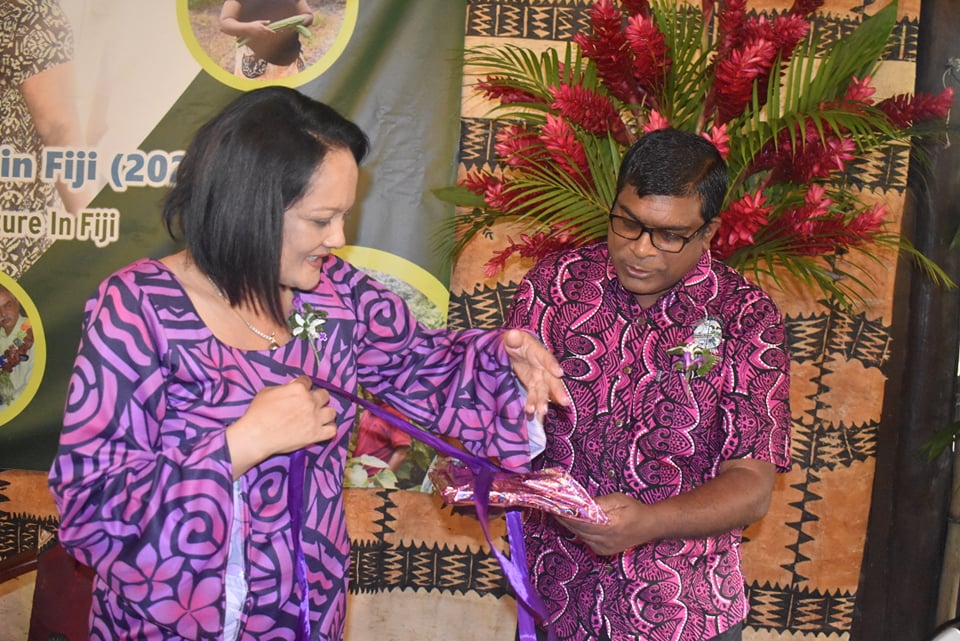AGRICULTURE MINISTRY TARGETS MORE RESOURCES FOR WOMEN'S DEVELOPMENT
March 17, 2022

Picture: Minister for Agriculture, Waterways and Environment Hon. Dr. Mahendra Reddy and Minister for Women Hon. Rosy Akbar during the launch of the Policy for Gender in Agriculture in Fiji.
The Ministry of Agriculture will earmark the allocation of more resources towards developing women in agriculture.
With the contribution of women towards the agriculture sectors’ overall growth and development being a pivotal aspect in the sector’s current economic status as a leading export earner, and as an impetus to increase their involvement, adequate resources will be assigned to foster more active engagement.
Speaking at the recent launching of the Policy for Gender in Agriculture in Fiji (2022-2027), Minister for Agriculture, Waterways and Environment Hon. Dr. Mahendra Reddy highlighted that the Ministry had put in place systems to bridge disparities that had previously existed in the system.
“I would like to especially acknowledge our women farmers who are present here today – thank you so much for all your contribution to the growth of Fiji’s agriculture sector. The 2020 Fiji Agriculture Census recorded 46.8% of Women participating in at least one agricultural activity – Crop, Livestock, Fisheries and Forestry and this finding indicates the importance of your involvement in achieving your household agricultural output.
“Fourteen (14) per cent of our women are actively engaged in the agriculture sector, we need to ensure that their number grows and we need to ensure that they are given not only recognition but have a dedicated amount of resources allocated to help them to better achieve their vision, outcome and objectives,” he said.
“So with the policy, we then can sharpen ourselves in terms of arguing for more resources,” added Hon. Reddy.
Minister Reddy also elaborated on the Women in Agriculture programme (which had an initial budgetary funding of $300K) as part of a new series of nine programmes targeted at improving the sector’s productivity portfolio, which women could utilise to apply for farming support materials like greenhouse and nursery materials, small farming tools, planting materials etc.
However, he added there was still more to be done to attract more women participation in agriculture; “the Ministry conducts several training on various commodities, and for all these training, we need to call people to come and attend those training, if we just sit in our office and say they didn’t apply, that’s why they’re not here, mostly only the men are here, that doesn’t work, it will take ages to bridge that disparity in terms of employment and equal opportunities.
“So all we’re saying is that we in the leadership position, we’re in charge of resources, we need to first accept that there is a disparity, accept that women play a very important and critical role in defining the quality of our livelihoods, so let’s reach out to them and say you need to be given some additional attention,” said Hon. Reddy.
“To assist the Ministry to do that and to ensure that we’ve got more dedicated resources, we thought we should have a dedicated policy but not only that, when you reach out to NGOs and link up with development partners, donor agencies, we will champion the Policy telling them we’ve launched the Policy, but what do we do with it when we don’t have adequate resources to implement it.
“Can you give us some money, rather than lumping it up and saying this is for livestock, can you dedicate some money for women in livestock and so forth, so this policy will help us not only to give you resources but to source resources as well,” said Minister Reddy.
Consequently, the 2020 Fiji Agriculture Census findings presented a Gender Report (Volume III –FAC 2020) which is a first in any Agriculture Census that has been conducted over the years.
The Gender report found that despite the involvement of women in the sector over the years, most women still practice subsistence agriculture whereby the number recorded tend to decrease when it comes to the identification of professional and commercial agriculture activity. So, despite the high incidence of women's participation in agriculture, only 14% of professional farmers are women.
-Ends-
